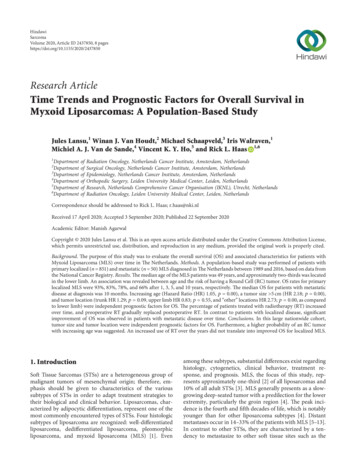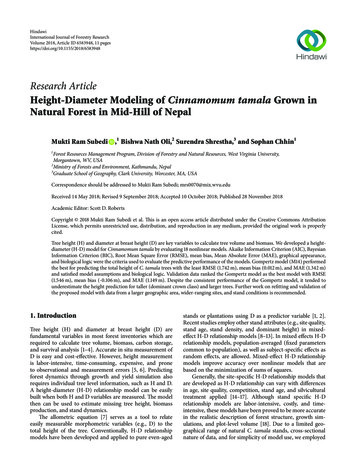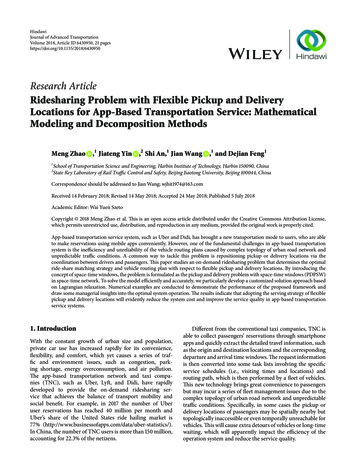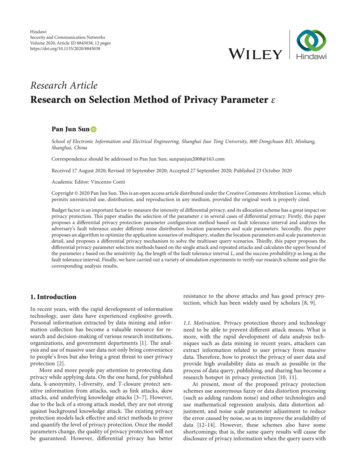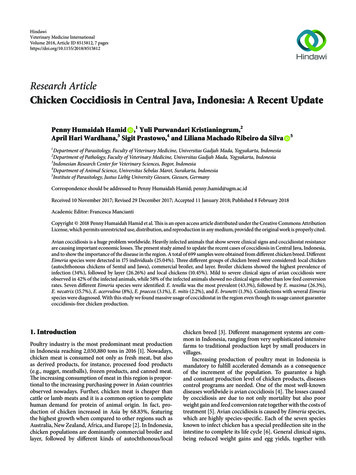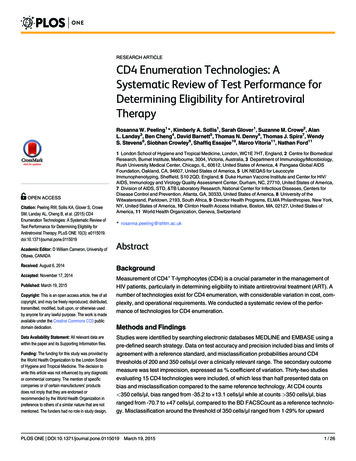
Transcription
RESEARCH ARTICLECD4 Enumeration Technologies: ASystematic Review of Test Performance forDetermining Eligibility for AntiretroviralTherapyRosanna W. Peeling1*, Kimberly A. Sollis1, Sarah Glover1, Suzanne M. Crowe2, AlanL. Landay3, Ben Cheng4, David Barnett5, Thomas N. Denny6, Thomas J. Spira7, WendyS. Stevens8, Siobhan Crowley9, Shaffiq Essajee10, Marco Vitoria11, Nathan Ford11OPEN ACCESSCitation: Peeling RW, Sollis KA, Glover S, CroweSM, Landay AL, Cheng B, et al. (2015) CD4Enumeration Technologies: A Systematic Review ofTest Performance for Determining Eligibility forAntiretroviral Therapy. PLoS ONE 10(3): e0115019.doi:10.1371/journal.pone.0115019Academic Editor: D William Cameron, University ofOttawa, CANADA1 London School of Hygiene and Tropical Medicine, London, WC1E 7HT, England, 2 Centre for BiomedicalResearch, Burnet Institute, Melbourne, 3004, Victoria, Australia, 3 Department of Immunology/Microbiology,Rush University Medical Center, Chicago, IL, 60612, United States of America, 4 Pangaea Global AIDSFoundation, Oakland, CA, 94607, United States of America, 5 UK NEQAS for LeucocyteImmunophenotyping, Sheffield, S10 2QD, England, 6 Duke Human Vaccine Institute and Center for HIV/AIDS, Immunology and Virology Quality Assessment Center, Durham, NC, 27710, United States of America,7 Division of AIDS, STD, &TB Laboratory Research, National Center for Infectious Diseases, Centers forDisease Control and Prevention, Atlanta, GA, 30333, United States of America, 8 University of theWitwatersrand, Parktown, 2193, South Africa, 9 Director Health Programs, ELMA Philanthropies, New York,NY, United States of America, 10 Clinton Health Access Initiative, Boston, MA, 02127, United States ofAmerica, 11 World Health Organization, Geneva, Switzerland* rosanna.peeling@lshtm.ac.ukAbstractReceived: August 6, 2014BackgroundAccepted: November 17, 2014Measurement of CD4 T-lymphocytes (CD4) is a crucial parameter in the management ofHIV patients, particularly in determining eligibility to initiate antiretroviral treatment (ART). Anumber of technologies exist for CD4 enumeration, with considerable variation in cost, complexity, and operational requirements. We conducted a systematic review of the performance of technologies for CD4 enumeration.Published: March 19, 2015Copyright: This is an open access article, free of allcopyright, and may be freely reproduced, distributed,transmitted, modified, built upon, or otherwise usedby anyone for any lawful purpose. The work is madeavailable under the Creative Commons CC0 publicdomain dedication.Data Availability Statement: All relevant data arewithin the paper and its Supporting Information files.Funding: The funding for this study was provided bythe World Health Organization to the London Schoolof Hygiene and Tropical Medicine. The decision towrite this article was not influenced by any diagnosticor commercial company. The mention of specificcompanies or of certain manufacturers’ productsdoes not imply that they are endorsed orrecommended by the World Health Organization inpreference to others of a similar nature that are notmentioned. The funders had no role in study design,Methods and FindingsStudies were identified by searching electronic databases MEDLINE and EMBASE using apre-defined search strategy. Data on test accuracy and precision included bias and limits ofagreement with a reference standard, and misclassification probabilities around CD4thresholds of 200 and 350 cells/μl over a clinically relevant range. The secondary outcomemeasure was test imprecision, expressed as % coefficient of variation. Thirty-two studiesevaluating 15 CD4 technologies were included, of which less than half presented data onbias and misclassification compared to the same reference technology. At CD4 counts 350 cells/μl, bias ranged from -35.2 to 13.1 cells/μl while at counts 350 cells/μl, biasranged from -70.7 to 47 cells/μl, compared to the BD FACSCount as a reference technology. Misclassification around the threshold of 350 cells/μl ranged from 1-29% for upwardPLOS ONE DOI:10.1371/journal.pone.0115019 March 19, 20151 / 26
CD4 Assay Performance: A Systematic Reviewdata collection and analysis, decision to publish, orpreparation of the manuscript.Competing Interests: S. Crowe is a co-developer ofthe Burnet POC CD4 test. This does not alter theauthors’ adherence to PLOS ONE policies on sharingdata and materials. All other authors have no conflictsof interest.classification, resulting in under-treatment, and 7-68% for downward classification resultingin overtreatment. Less than half of these studies reported within laboratory precision or reproducibility of the CD4 values obtained.ConclusionsA wide range of bias and percent misclassification around treatment thresholds were reported on the CD4 enumeration technologies included in this review, with few studies reporting assay precision. The lack of standardised methodology on test evaluation, includingthe use of different reference standards, is a barrier to assessing relative assay performance and could hinder the introduction of new point-of-care assays in countries wherethey are most needed.IntroductionThe increased availability of antiretroviral therapy (ART) has resulted in major reductions inmorbidity and mortality in high HIV burden settings. Through significant global scale-up, access to ART is increasing, with around 10 million people in low- and middle-income settingsreceiving treatment as of the end of 2013, an estimated 65% of the of the global target of 15 million people set for 2015 [1].CD4 T-lymphocytes, also known as the helper T-cells, are the coordinators of the immuneresponse that protects the body against microbial disease, a variety of autoimmune diseasesand some forms of cancer. The destruction of CD4 T-lymphocytes by HIV is the main causeof the progressive weakening of the immune system in HIV infection, and leads ultimately toacquired immune deficiency syndrome (AIDS). The CD4 count is a strong predictor of HIVprogression to AIDS and death, and is considered the best laboratory marker for decidingwhen to initiate ART [2,3]. The use of clinical staging alone to determine the timing of ARTinitiation is limited by the unreliable correlation between asymptomatic or mild disease andshort-term prognosis and may result in dangerous delays in treatment initiation in those without symptoms but with severe immune suppression [4].Prior to 2013, the World Health Organization (WHO) recommended ART initiation inall HIV-infected individuals whose CD4 count has dropped to 350 cells/μl, irrespective ofclinical symptoms. The WHO 2013 guidelines have raised the threshold for ART initiation to 500 cells/μl, with priority given to those with a CD4 count to 350 cells/μl, consistent withemerging data, indicating a clinical and public health benefit of earlier treatment and as part ofa global effort to get 15 million HIV patients on ART by end of 2015 [5].A number of technologies are available for CD4 enumeration, with considerable variationin cost, complexity, and operating requirements (Tables 1–5). The traditional approach to calculating absolute CD4 T lymphocyte counts is to use the total leukocyte count (or lymphocytecount) obtained from the hematology analyzer and then use the percentage CD4 T lymphocytes from the flow cytometric analysis to calculate the absolute values—the so-called “dualplatform” (DP) approach. Quite often, however, two separate samples are used in the procedure, one to obtain the total leukocyte count using a hematology analyzer and one to undertakethe flow cytometry, each having its own in-built variation. Thus, when the results from eachare combined to determine the absolute CD4 T lymphocyte count, the variation is compounded such that inter-laboratory variation between centers can be as high as 40%. Thus, theneed to derive accurate and precise absolute CD4 T lymphocyte counts has led to thePLOS ONE DOI:10.1371/journal.pone.0115019 March 19, 20152 / 26
CD4 Assay Performance: A Systematic ReviewTable 1. Operating characteristics of flow cytometric methods for CD4 T-cell enumeration, using conventional flow cytometers.FLOW CYTOMETRY USING CONVENTIONAL FLOW CYTOMETERaConventional dual platformBead-based single platform technology on conventional flowcytometerPanleucogatingAssay nameVariousTrucount tubesFlow-CountbeadsPerfect-CountPLG CD4ManufacturerVariousBecton DickinsonBeckmanCoulterCytognosBeckman CoulterCompatible with various reagent systems and flow cytometersCompatible with variousreagent systems andflow cytometersInstrumentationFlow cytometer plus haematologyanalyserFlow cytometerGating strategyAssay principleAbsolute count calculated usingresults from flow cytometrytogether with the total lymphocytecount from haematology analyserAbsolute CD4 counts determined using ratio of CD4 to a knownquantity of fluorescent beads—no need for haematology analyserGating strategy usingtotal white cell countAbsolute CD4 and CD4%Absolute CD4 and CD4%Absolute CD4 andCD4%Up to 100μl whole blood in EDTA100μl whole blood inEDTAParametersmeasuredTrucount tubescontain premeasuredquantity of lyophilisedbeadsLiquid beadsneed accuratepipetting byoperatorTwo different beadpopulations allowdetection ofinadequate mixingOthers depend on reagent kits/methodsSpecimen500μl whole blood in EDTAThroughputUp to 250 samples/dayUp to 250 samples/dayCompatible withindependent EQA/PTprogrammes?YesYesYesYesYesIs there access tocompatible fullprocess QC reagent?YesYesYesYesN/AMaximum length oftime from blood drawto testing24 hours24 hoursCan the test beperformed on fixed/stabilised bloodYesYesComplexity/trainingrequiredComplex. Significant trainingrequired.Complex. Significant training requiredModerate res uninterrupted mainselectricityRequires uninterrupted mains electricityRequires uninterruptedmains electricityRobustness to heat/humidityClimate control recommendedClimate control recommendedClimate controlrecommendedReagents require refrigerationReagents require refrigerationReagents requirerefrigerationaUp to 250 samples/day5 daysYesYesYesVarious flow cytometers available from various manufacturers. Examples include Becton Dickinson FACSCalibur, Beckman Coulter Epics t of instruments that can produce both percentage and absolute values, termedthe”single platform” approach (SP).Two SP approaches are in widespread use today: volumetric and bead based. The principleof the volumetric approach is that a known volume of sample is passed through the flow cell(and interrogated by the laser beam) in a known amount of time. The alternative approach isPLOS ONE DOI:10.1371/journal.pone.0115019 March 19, 20153 / 26
CD4 Assay Performance: A Systematic ReviewTable 2. Operating characteristics of dedicated single platform CD4 T-cell enumeration systems.DEDICATED SINGLE PLATFORM CD4 SYSTEMSAssay nameFACSCountGuava PCAPartec CyFlow Counter orCyFLow SL 3Apogee Auto40ManufacturerBecton DickinsonMillipore (formerly GuavaTechnologies and now a divisionof Merck)PartecApogee flow systemsInstrumentationFlow cytometerFlow cytometerFlow cytometerFlow cytometerAssay principleDedicated single platformbead-based flowcytometer, two colour, nolyse no-washSingle platform volumetric flowcytometer. Microcapillary flowcell. Previously used EasyCD4reagents (EasyCD4 system),since replaced by Auto CD4/CD4%. Company also producesthe more complex easyCyteinstruments, for research useonly.Volumetric SP flow cytometer. Upto 3 parameters (2 colour plusSSC). Simplest is singleparameter CD4. For CD4%, 2colour (CD45/4) SSC. SL 3(also called SL green) operateson the same principles but isadaptable to wider applications.Other CyFlow instruments suchas SL blue have a wider range ofparameters and potentialapplications.Volumetric flow cytometerParametersmeasuredAbsolute CD4 count andCD4%Absolute CD4 count and CD4%Absolute CD4 count and CD4%Absolute CD4 and CD4%Specimen50μl whole blood in EDTA10μl whole blood in EDTA20μl whole blood in EDTA50μl whole blood in EDTAThroughput 30 samples/hour, at CD4counts 400100–150 samples/day250 samples/day, 400 samples/day with loader20 samples/hourCompatible withindependent EQA/PT programmes?YesYesYesNo data availableIs there access tocompatible fullprocess QCreagent?YesNo manufacturer-produced fullprocess controlManufacturer produces drystabilised control bloodNo manufacturer-producedfull process controlMaximum length oftime from blood drawto testingStain within 48 hours ofdraw (24 hours for CD4%)(store at 20–25 C),analyse within 48 hours ofstaining.48 hours48 hoursPreferably run within 6–8hours unless stabilisedCan the test beperformed on fixed/stabilised bloodYesYesYesYesComplexity/trainingrequiredOne day trainingOne day trainingModerate training requirementOne day trainingEnvironmental/energy issuesRequires uninterruptedmains electricityRequires uninterrupted mainselectricity Less biohazardouswaste (reduced by 100 fold)Mains electricity or car battery orsolar panelsUPS with battery back upincluded. Optional inverterallows instrument to bepowered by vehicle batteryRobustness to heat/humidity10–35 C, 5–95% noncondensing humidity.Reagents requirerefrigeration.Instrument: up to 35 C. 10–90%non-condensing relative humidity.Reagents require refrigeration.Solid state laser more stable thanwater or air cooled gas lasers athigh temperatures. Liquidreagents require refrigeration, ordry reagent kits available whichcan be stored at up to 60 C indark for up to 12 monthsOption of thermostablereagents with 9 month shelflife at room temperature.Instrument: 5–35 C, 90%humidity.PCA personal cell analysis, SSC side scatter.doi:10.1371/journal.pone.0115019.t002PLOS ONE DOI:10.1371/journal.pone.0115019 March 19, 20154 / 26
CD4 Assay Performance: A Systematic ReviewTable 3. Operating characteristics of manual technologies for CD4 T-cell enumeration.MANUAL METHODSAssay nameCoulter Manual CD4 Count Kit (Cytospheres)Dynal T4 Quant Kit (Dynabeads)ManufacturerBeckman CoulterInvitrogen/Dynal BiotechInstrumentationLight microscope, haemocytometerFluorescent or light microscope, haemocytometer, magnetAssay principleInert latex spheres coated with monoclonal Ab formrosettes on contact with CD4 cells—readily visible bylight microscopyMagnetic polystyrene beads, coated with mouse monoclonal Ab,allow isolation of CD4 T cells followed by counting usingfluorescent (preferable) or light microscopeParameters measuredAbsolute CD4 countAbsolute CD4 countSpecimen100μl whole blood in EDTA125μl whole blood in EDTA or ACDThroughput10 samples/day. Operator fatigue a limitation.Suggest stop counting at 500 cells. Batch size limitedto 2 samples10 samples/day. Operator fatigue a limitation. Suggest stopcounting at 500 cells. Batch size limited to 6 samplesCompatible with independentEQA/PT programmes?NoNoIs there access to compatiblefull process QC reagent?NoNoMaximum length of time fromblood draw to testing72 hours at 20 C72 hours at 20 CCan the test be performed onfixed/ stabilised bloodNoCompatible with Cyto-Chex (Streck, USA) stabilised refrigeratedsamples up to 9 days after collection. Not compatible withTransFix (CytoMark, UK).Complexity/training required1–3 days training1–3 days trainingEnvironmental/energy issuesRequires power for microscopeRequires power for microscopeRobustness to heat/humidityReagents need refrigerationReagents need Table 4. Operating characteristics of other commercially available technologies for CD4 T-cell enumeration.OTHER COMMERCIALLY AVAILABLE TECHNOLOGIESAssay namePocH-100i/KX-21N with Dynal DynabeadsCD4 SelectManufacturerSysmexi MED Laboratories Co. Ltd.InstrumentationHaematology analyserHaematology analyser, magnet, rotatorAssay principleCD4 cell isolation using modified Dynal dynabeads,counting using haematology analyser with specificsoftwareFerrous beads coated with MT4 mAb bind to CD4 T cells, whichare then removed using magnet. Whole blood and CD4-depleteblood counted on haematology analyser. CD4 count and %calculated using established formulaeParameters measuredAbsolute CD4 count and CD4%Absolute CD4 and CD4%Specimen125 μl whole blood in EDTA400μl whole blood in EDTAThroughput12 samples/hourNo data availableCompatible with independentEQA/PT programmes?No EQA evaluation data availableNo EQA evaluation data availableIs there access to compatiblefull process QC reagent?No data availableNo data availableMaximum length of time fromblood draw to testing24 hours at 4 or 20 CNo data availableCan the test be performed onfixed/ stabilised bloodNo data availableNo data availableComplexity/training requiredModerate complexityModerate complexityEnvironmental/energy issuesRequires power for haematology analyserRequires power for haematology analyser and rotatorRobustness to heat/humidityNo data availableNo data availabledoi:10.1371/journal.pone.0115019.t004PLOS ONE DOI:10.1371/journal.pone.0115019 March 19, 20155 / 26
CD4 Assay Performance: A Systematic ReviewTable 5. Operating characteristics of Point of Care (POC) technologies for CD4 T-cell enumeration.POINT OF CARE TECHNOLOGIESAssay namePointCare NOWPimaCyFlow miniPOCManufacturerPointCare TechnologiesAlere (formerly Inverness Medical)PartecInstrumentationPoint of care instrumentPoint of care instrumentPoint of care instrumentAssay principleCD4 and haematology contained in one unit.All test reagents sealed withindisposable cartridge.Compact flow cytometricdevice. Uses dry reagentsGold nanoparticles conjugated to CD4 antibodies(no fluorescence). LED light source.Portable analyser uses static imageanalysis and cell counting principlesAbsolute CD4, CD4%, Hb, differential white cellcountAbsolute CD4Parameters measuredAbsolute CD4 and CD4%Specimen40μl whole blood in EDTA25μl capillary or venous blood20μl whole blood in EDTAThroughput50 samples/day3 samples/hour250 samples/dayCompatible with independentEQA/PT programmes?NoUnder investigationCompatible with GermanEQA programmeIs there access to compatiblefull process QC reagent?No data availableNo data availableCompany produce drystabilised blood samples forQCMaximum length of time fromblood draw to testing8 hours24 hoursProvisional data suggest 24hrsCan the test be performed onfixed/ stabilised bloodNo data availableCompatible with Transfix (CytoMark,UK)No data availableComplexity/training y issuesRequires mains or battery powerRequires mains or battery powerRequires mains or batterypowerRobustness to heat/humidityReagents do not require refrigeration.Instrument: 18–34 C, 80% relative humidity,non-condensingNo refrigeration required (driedreagents)No refrigeration required(dried reagents)doi:10.1371/journal.pone.0115019.t005to use bead-based technologies where a known number of beads is added to a known volumeof sample thus allowing calculation of the bead to cell ratio and the subsequent calculation ofthe absolute cell count, in this instance, CD4 T lymphocytes. An important feature of any absolute counting system is pipetting accuracy and minimum sample manipulation. The introduction of SP technologies has had a beneficial effect and lowered inter-laboratory variation inCD4 enumeration.It is critical that country programmes consider whether these tests can give accurate and reproducible results as well as being appropriate for the setting [6]. In particular, we focussed onhow bias and misclassification probabilities of different CD4 assays may affect eligibility forART initiation. Misclassification probabilities give clinically useful measures of test performance and should be reported in evaluations of CD4 technologies. An upward misclassification around a treatment threshold means that a patient who should be eligible for treatmentwould be denied treatment, while a downward misclassification would not lead to ineligibilityfor treatment. To date, there have been no systematic reviews of the performance of CD4 technologies. Here we provide an evaluation of the performance characteristics of CD4 technologies through a systematic review of published literature.MethodsWe performed a systematic review of studies evaluating the performance of CD4 enumerationtechnologies. A search of the Cochrane Library and the Centre for Reviews and DisseminationPLOS ONE DOI:10.1371/journal.pone.0115019 March 19, 20156 / 26
CD4 Assay Performance: A Systematic Reviewdatabases, including the Database of Abstracts of Reviews of Effects (DARE), the NationalHealth Service Economic Evaluation Database (NHS EED) and the National Institute forHealth Research Health Technology Assessment (NIHR HTA) database found no existing reviews addressing the review objective.We followed standard guidance in performing the review [7]. Objectives and methods ofthe review were documented in a review protocol, which is included as S1 Methods.Eligibility criteriaEligibility criteria were defined using the PICOS (Population, Interventions, Comparisons,Outcomes, Study Design) format. Studies evaluating the accuracy and/or precision of any CD4technology commercially available at the time of the review were considered eligible for inclusion. Currently, no “gold” standard technology or internationally recognised reference preparation exists for CD4 enumeration, and a wide range of flow cytometric technologies have beenused as comparators [6].For the purposes of this review, we included studies that used as reference technologies anyflow cytometric method considered to be acceptable by the WHO HIV diagnostics workinggroup named in the review protocol (S1 Methods).Information SourcesStudies were identified by searching two electronic databases—MEDLINE and EMBASE, scanning the reference lists of the Nature supplement Evaluating diagnostics: the CD4 guide, and byinviting the WHO working group, whose members are authors of the Nature supplement toidentify relevant studies for the review [6,8].Search StrategyWe used the following search terms to search the electronic databases: “CD4”, “technolog ”,“methodolog ”, “techn ”, “method ”, “test”, “evaluation”, “validation”, “accuracy”, “comparison”, “efficacy”, “performance”, “reproducibility”, “precision”, “flow AND cytometry”. Subjectheadings included: “CD4 antigen”, “antigens, CD4”, “CD4 lymphocyte count”, “CD4-positiveT-lymphocytes”, “technology”, “methodology”, “technique”, “evaluation”, “clinical evaluation”,“economic evaluation”, “evaluation research”, “evaluation and follow up”, “instrument validation”, “validation process”, “validation study”, “evaluation studies as topic”, “validation studies”, and “flow cytometry”. Full electronic search strategies and review protocols are detailed inS1 Methods.Study selectionArticles were exported from the search database to EndNote and screened for relevance(Fig. 1). Data were extracted by two independent reviewers (SG and KS) and disagreements resolved through consensus.Data extractionThe following data were extracted: study location, index test, reference test, and population(HIV positive or HIV positive and negative). Data on accuracy and precision included bias ormean difference and limits of agreement, misclassification probabilities (when sensitivity orspecificity values were given, misclassification probabilities were calculated), and coefficient ofvariation. Where possible, HIV positive data alone were extracted. Where this was not possible,PLOS ONE DOI:10.1371/journal.pone.0115019 March 19, 20157 / 26
CD4 Assay Performance: A Systematic ReviewFig 1. PRISMA flow diagram of study selection. EQA: external quality assurance, FC: flow S ONE DOI:10.1371/journal.pone.0115019 March 19, 20158 / 26
CD4 Assay Performance: A Systematic Reviewcombined HIV positive and negative data were extracted. Only data within the clinically relevant range (thresholds of 200, 350, 500 cells/μl) were extracted as per the inclusion criteria.Studies should report not only percent misclassification around clinically important CD4cell thresholds (e.g., 200, 350 or 500 cells/μl), but should also report the magnitude ofthese misclassifications.The secondary outcome measure addressed precision or reproducibility. Precision is particularly important when following a patient’s serial measurements using the same technology.Precision can be measured within-laboratory or between-laboratories and is expressed as percent coefficient of variation (%CV).Studies meeting inclusion criteria were also assessed for bias and quality on ten pointsdrawn from the STARD guidelines (Fig. 2) [9]. This review has been reported following thePRISMA statement guidance for reporting of systematic reviews [10,11].ResultsA summary of different commercially available CD4 technologies, including their assay principles, operational characteristics and compatibility with international external quality assuranceprogramme reagents, is shown in Tables 1–5. Conventional flow cytometry based technologiesinclude DP technologies such as the BD FACSCalibur (BD Biosciences, a division of BectonDickinson, Franklin Lakes, NJ, USA [BD]) and the Epics XL (Beckman Coulter, Inc., Pasadena,CA, USA [BC]); bead-based SP technologies such as the BD Trucount Tube, the BC FlowCount Tubes, the Cytognos Perfect Count (Cytognos S.L., Salamanca, Spain [Cytognos]), andthe BC Pan-leucogating (PLG) FlowCare CD4. Dedicated SP CD4 technologies include beadbased BD FACSCount, and three volumetric assays, Millipore Guava PCA (EMD Millipore,Darmstadt, Germany [Guava]), Partec CyFlow Counter (Partec, a division of Sysmex, Corporation, Kobe, Japan [Partec]) and Apogee Auto40 Flow Cytometer (Apogee Flow Systems,Hertfordshire, UK [Apogee]). There are two manual microscopy based counting methods, theBC Cytospheres and the Dynal T4 Quant (Dynal Biotech ASA, a division of Thermo Fisher Scientific Inc., Waltham, MA, USA [Dynal]). Point-of-care (POC) analysers include the SysmexpocH-100i with Dynabeads from Dynal, the i MED CD4 Select (i MED Laboratories, Bangkok, Thailand [i MED]), the Pima Analyzer (Alere Inc., Waltham, MA, USA [Alere]), andPointCare NOW (PointCare Technologies, Marlborough, MA, USA [PointCare]).Study selectionThis systematic review was first performed in July 2009. Of the 433 studies in the search, 345were excluded as they were not performance evaluations. After further triage, 20 studies thatmeasured bias, misclassification and/or %CV were accepted for inclusion in this review(PRISMA flow diagram, Fig. 1). A second search was conducted in April 2013 using the samesearch strategy and review protocol with the goal of capturing more POC CD4 enumerationtechnologies in the review. An additional 12 studies were included. A summary of data extracted from all eligible studies with data on bias, misclassifications and/or %CV is shown inS1 Dataset.Study characteristicsA summary of study characteristics is shown in Table 6.At least one published performance evaluation study was found for each of the followingtechnologies: BC Cytospheres [12–18], Dynal Dynabeads [14,18–22], Guava PCA [23–29],Partec CyFlow instruments [16,26,30–36], BD FACSCount [14,37–42]; BD Trucount tubes[43–46], BC Flow-Count fluorospheres [47], Cytognos Perfect-Count microspheres [48], SPPLOS ONE DOI:10.1371/journal.pone.0115019 March 19, 20159 / 26
CD4 Assay Performance: A Systematic ReviewFig 2. Methodological quality of included studies. EQA: external quality assurance, IQC: internalquality control.doi:10.1371/journal.pone.0115019.g002PLOS ONE DOI:10.1371/journal.pone.0115019 March 19, 201510 / 26
CD4 Assay Performance: A Systematic ReviewTable 6. Characteristics of included studies.StudyLocationLaboratory orhealthcare levelat which thestudy wasperformedReferencestandardIndex test (testunder evaluation)PopulationNo. of samplesused inaccuracystudies (n)Balakrishnan 200412Chennai, IndiaCharitablefoundation clinical/research labBD FACSCountCoulterCytospheresHIV pos122Carella 199513USATeaching hospital /research lab?DP FCCoulterCytospheresHIV pos and neg117Landay 199317USA and UgandaUniversity researchhospitalsDP FCCoulterCytospheresHIV pos and neg382Gernow 199515Denmark andIvory CoastNot clearDP FCCoulterCytospheresHIV pos and neg123Didier 200114ParisTeaching hospitallabSP FC using BDTrucount tubesCoulterCytospheresHIV pos and neg55SP FC using BDTrucount tubesDynal DynabeadsHIV pos and neg46SP FC using BDTrucount tubesBD FACSCountHIV pos and neg45DP FCCoulterCytospheresHIV pos131, from 102donorsDP FCPartec CyFlowCounter CD4/SCCNLNWHIV pos128 from 121donorsBD FACSCount orFACSCaliburCoulterCytospheresHIV pos1444 ( 497donors)BD FACSCount orFACSCaliburDynal DynabeadsHIV pos1671Karcher 200616Lutwama 200818UgandaUgandaLocal lab, fieldconditionsUniversitylaboratoryDiagbouga 200319Five countries inWest AfricaLocal laboratoriesSP FC using BDTrucount tubesDynal DynabeadsHIV pos657, from 301donorsImade 200521NigeriaUniversity hospitallaboratoryPartec CyFlowDynal DynabeadsHIV pos and neg40Idigbe 200620NigeriaResearchlaboratoryBD FACSCountDynal DynabeadsHIV pos and neg97 (46 HIV pos,51 neg)Balakrishnan 200623Chennai, IndiaCharitablefoundation clinical/research labBD FACSCountGuava Easy CD4HIV pos and neg228Kandathil 200524South IndiaMedical collegelaboratory andcharitablefoundation clinical/research laboratoryBD FACSCountGuava Easy CD4HIV pos and neg72 (51 HIV pos,21 neg)Spacek 200628United StatesUniversitylaboratoryDP FCGuava Easy CD4HIV pos77UgandaUniversitylaboratoryBD FACSCountGuava Easy CD4HIV pos141Thakar 200629Pune, IndiaResearch instituteDP FCGuava Easy CD4HIV pos79Pattanapanyasat200725Bangkok, ThailandTeaching hospitallaboratory andministry of publichealth-cdc labSP FC using BDTrucount tubesGuava Easy CD4HIV pos250BD FACSCountGuava Easy CD4HIV pos250Pattanapanyasat200826ThailandTeaching hospitallaboratorySP FC using BDTrucount tubesGuava Easy CD4HIV pos150(Continued)PLOS
Instrumentation Flow cytometer Flow cytometer Flow cytometer Flow cytometer Assay principle Dedicated single platform bead-based flow cytometer, two colour, no-lyse no-wash Single platform volumetric flow cytometer. Microcapillary flow cell. Previously used EasyCD4 reagents (EasyCD4 system), since replaced by Auto CD4/ CD4%. Company also .
